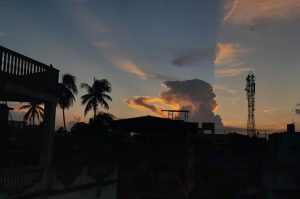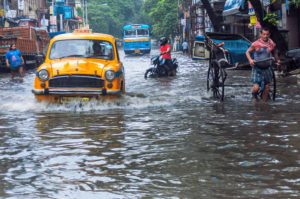Kolkata Weather Forecast: The City of Joy continues to grapple with warm and sticky weather as high humidity levels linger over the region, punctuated by occasional spells of rain. According to forecasts from the India Meteorological Department (IMD), the coming days will bring intermittent showers, localized thunderstorms, and oppressive humidity, making life challenging for residents already weary of the prolonged discomfort.

Current Weather Snapshot
As of Sunday, the city has been experiencing daytime temperatures hovering around 33–35°C, but the “real feel” is several degrees higher due to moisture-laden winds from the Bay of Bengal. The relative humidity, which remains in the 80–90% range during peak hours, has amplified the discomfort. Evening showers have brought brief respite, but not enough to break the muggy spell.


Meteorologists at Alipore weather office have indicated that cloud formation will intensify in the afternoons and evenings, leading to sudden bursts of rain or thunderstorms. However, rainfall distribution is expected to remain uneven across neighborhoods.
“The monsoon trough is active over the Gangetic Bengal region, but there are variations in intensity. While some areas may experience heavy downpours, others will see only light drizzle,” an IMD official explained.
A Pattern of Sultry Afternoons and Wet Evenings
Kolkata’s weather over the past week has followed a familiar pattern: hot, humid afternoons giving way to rainy evenings. In areas such as Salt Lake, Park Street, Behala, and Howrah, residents have reported heavy rainfall in short bursts, leading to waterlogging on major arterial roads. By contrast, pockets in North Kolkata such as Shyambazar and Dum Dum saw light showers, with humidity persisting despite the drizzle.


The uneven rainfall has highlighted a long-standing urban issue: drainage and waterlogging. Even 30–40 minutes of rainfall is enough to flood several low-lying zones, leading to traffic jams and inconvenience for daily commuters.
Monsoon Outlook: August to Bring Fluctuating Weather
Weather experts predict that August will see frequent spells of rain accompanied by sultry conditions. The southwest monsoon, though active, has not delivered consistent rainfall across Bengal, resulting in worries for both urban residents and the agricultural sector.
Farmers in the South 24 Parganas, Hooghly, and Nadia districts have raised concerns about inadequate rainfall, which could affect paddy sowing. On the other hand, excessive showers in short bursts have damaged standing crops in parts of North Bengal.
Climate scientists have also warned of an emerging trend: erratic monsoon behavior due to climate change. Kolkata, once known for predictable wet months between June and September, is now experiencing sudden, high-intensity rainfall events interspersed with dry spells, disrupting both city life and rural agriculture.
Health Concerns: Rise in Heat-Related Illnesses
The prolonged spell of humid weather has contributed to a surge in heat exhaustion, dehydration, and vector-borne diseases. City hospitals have reported higher cases of patients complaining of fatigue, headaches, and heat rashes. Doctors are urging residents to remain hydrated and avoid long exposure to the afternoon sun.
At the same time, stagnant water from intermittent rains has raised fears of dengue, malaria, and chikungunya outbreaks. Last year, Kolkata reported a sharp spike in dengue cases during the late monsoon months, and municipal authorities are already conducting fogging drives and drain cleaning operations in vulnerable neighborhoods.
“The combination of warm weather and intermittent rains is ideal for mosquito breeding. Precautionary measures must be taken now to prevent a repeat of last year’s dengue outbreak,” said a senior physician at a government hospital.
Daily Life and Public Response
For the city’s residents, the current weather has become a balancing act between relief and frustration. Many welcome the evening showers as they bring down temperatures temporarily, but commuters often struggle with waterlogged streets, traffic snarls, and delays in public transport.
Street vendors and small businesses also face challenges, as sudden downpours affect footfall in busy markets such as New Market, Gariahat, and Hatibagan. Ride-hailing drivers and auto operators have reported longer waiting times and increased demand during rain spells.
Despite the discomfort, the rains have added a seasonal charm. Kolkata’s cultural life often intertwines with the monsoon, from tea stalls filled with chatter over samosas and pakoras to evening addas under dripping tin shades. Photographers and artists also capture the romantic appeal of rain-soaked streets, tramlines glistening, and yellow taxis splashing through puddles.
The Science Behind the Humidity
Meteorologists attribute Kolkata’s sticky conditions to moist winds from the Bay of Bengal and the geographical setting of the city. Unlike coastal areas with stronger sea breezes, Kolkata’s location inland means that the moisture settles and lingers, raising humidity levels.
Additionally, urban heat island effects—caused by concrete structures, traffic emissions, and reduced greenery—trap heat in the city core, making evenings less breezy. Climate experts warn that unless the city invests in sustainable urban planning and increased green cover, conditions are likely to worsen in the coming years.
Measures by Authorities
The Kolkata Municipal Corporation (KMC) has stepped up efforts to combat weather-related challenges. Measures include:
- Deployment of quick-response teams to clear clogged drains during heavy rainfall.
- Awareness campaigns on dengue prevention and safe drinking water.
- Coordination with traffic police to manage waterlogging-prone intersections.
- Monitoring rainfall patterns through upgraded Doppler radar systems.
Kolkata Weather Forecast: Looking Ahead
According to IMD’s extended forecast, Kolkata will continue to experience alternating spells of humid conditions and scattered showers over the next two weeks. Citizens have been advised to carry umbrellas and rain gear while commuting, and to stay updated through official weather bulletins.
The broader question, however, looms larger: Can Kolkata adapt to the growing unpredictability of its climate? The balance between infrastructure, health preparedness, and sustainable planning will determine how the city weathers the coming years.
External References for Further Reading:
- India Meteorological Department – Official Kolkata Weather Updates
- Kolkata Municipal Corporation
- Climate Change and Monsoon Variability – Down To Earth
- World Health Organization: Climate and Health
Also read: Home | Channel 6 Network – Latest News, Breaking Updates: Politics, Business, Tech & More

